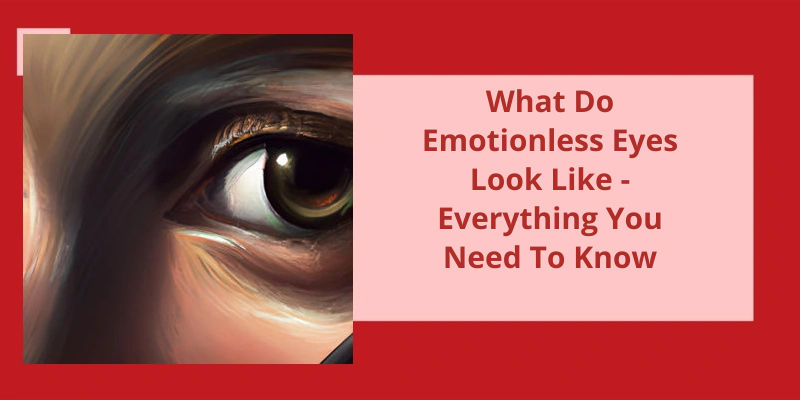Eyes are often considered to be windows to the soul, capable of conveying a wide array of emotions and feelings. However, there are instances where the absence of emotions within a person's eyes becomes apparent, presenting a distinct and enigmatic appearance. Understanding what emotionless eyes look like and the underlying factors behind this phenomenon can provide valuable insights into human behavior and psychology. Join us as we explore the captivating world of emotionless eyes and unravel the secrets they hold.
How Do Eyes Display Emotion?
The eyes are often referred to as the windows to the soul because they’ve the remarkable ability to display a wide range of emotions. When we experience emotions, our eyes reveal what we’re feeling deep within. Whether it be love, anger, fear, suspicion, exasperation, boredom, or sadness, the eyes are the primary conveyors of these emotions.
In moments of love, our eyes soften and become more relaxed. They sparkle with affection and warmth, and sometimes even appear to glow. Love brings about a sense of vulnerability, and our eyes reflect this by becoming softer and more gentle.
On the other end of the spectrum, anger causes our eyes to harden and become intense. The pupils may dilate, and the brows can furrow, creating a fierce and intimidating gaze. The strong emotions associated with anger are clearly visible through the eyes, as they project strength and determination.
When faced with fear, our eyes widen and become alert. They actively search for potential threats, constantly on guard. Fear manifests in the eyes as a sense of urgency and heightened sensitivity. This wide-eyed expression is a primal instinct ingrained in humanity, allowing us to quickly react to danger.
Suspicion narrows our eyes, creating a look of skepticism and disbelief. The eyes may dart around, searching for signs of deception or hidden intentions. Suspicion creates a guarded and critical gaze, warning others that trust isn’t freely given.
Exasperation causes our eyes to roll, reflecting a sense of annoyance and frustration. The eyes may momentarily lose focus as a sign of weariness or irritation. This rolling of the eyes is often accompanied by a sigh, indicating exasperation and impatience.
Boredom can be detected in the eyes as they glaze over, losing their sparkle and vitality. They may become blank and vacant, expressing a lack of interest or stimulation.
Sadness, perhaps one of the most recognizable emotions, causes the eyes to well up with tears. They become glassy and appear distant, reflecting the internal pain and sorrow. When someone is sad, their eyes reveal their vulnerability, calling out for comfort and understanding.
The eyes truly are the windows to our emotions. They’ve the incredible ability to reflect and communicate what we feel inside. So the next time you look into someones eyes, take a moment to truly see the emotions they’re expressing.
Lifeless eyes refer to a state in which one’s eyes lack emotion, depth, or expression, often appearing vacant or dull. This term is often used metaphorically to describe individuals who seem disconnected or disengaged from their surroundings, displaying a lack of enthusiasm or vitality. Despite their physical presence, their eyes fail to convey the usual spark or liveliness typically associated with human emotions.
What Are Lifeless Eyes?
Lifeless eyes, also known as emotionless eyes, refer to a lack of expressiveness or vitality in a persons gaze. These eyes often appear vacant, devoid of any warmth, passion, or liveliness.
Though it can be disconcerting to encounter people with lifeless eyes, it’s important to recognize that this may not necessarily reflect their true emotional state. While some individuals naturally have less expressive eyes due to factors like genetics or personality traits, others may be experiencing emotional distress or deep-rooted issues that make it challenging for them to connect with their emotions or others.
While they can be disconcerting, it’s essential to approach individuals with empathy and understanding, as the cause may be various and complex. By focusing on their overall demeanor and engaging in meaningful conversations, a deeper connection can be fostered despite the seemingly emotionless eyes.
Source: What do “empty/lifeless eyes” mean?
It’s often said that the eyes are the window to the soul. They’ve the unique ability to convey deep emotions and inner thoughts without the need for words. However, there are instances where someone’s eyes may appear soulless, devoid of any emotion or passion. While it may not be solely dependent on the eyes themselves, this expression is often reflected in the dilation of the pupils, position of the lids, and the overall facial expression. Let’s dive deeper into the concept of soulless eyes and explore what it truly means.
What Does It Mean to Have Soulless Eyes?
Soulless eyes are often associated with a lack of emotion or passion. It’s not necessarily about what’s displayed in the eyes themselves, but rather the overall expression and position of the lids.
In addition to the eyes, the face also plays a role in portraying soulless eyes. The lack of expression or any hint of excitement further emphasizes the emptiness in their gaze.
It can simply be a temporary state or a reflection of their current emotional state.
Causes of Soulless Eyes: Explore Different Factors That Can Lead to the Appearance of Soulless Eyes, Such as Depression, Trauma, or Certain Medical Conditions.
There are various factors that can contribute to the appearance of emotionless or soulless eyes. One common cause is depression, which can lead to a lack of expression or vitality in the eyes. Trauma, especially emotional or psychological trauma, can also result in a vacant or hollow look in the eyes. Certain medical conditions, such as schizophrenia or certain neurological disorders, can affect facial muscles and expressions, giving a person a seemingly emotionless gaze. It’s important to remember that the appearance of soulless eyes doesn’t necessarily mean a person lacks emotions, as external factors may be influencing their expression.
The eyes, often described as the windows to the soul, possess a remarkable ability to reveal our deepest emotions. They convey a multitude of feelings, from joy and happiness to sadness and distress, through subtle changes in their appearance. A mere glance can sometimes offer a glimpse into the complex landscape of human emotion. But is it possible to accurately decipher someone’s internal state based solely on the expressions in their eyes? Recent research suggests that our eyes may indeed hold valuable clues about how we feel.
Can Your Eyes Tell How You Feel?
Our eyes are truly windows to our emotions. They’ve the ability to speak volumes without uttering a single word. When we experience happiness, our eyes radiate joy. They seem to light up, and the pupils naturally dilate, giving an aura of warmth and positivity. It’s as if the eyes themselves are mirroring the happiness we feel inside.
Conversely, when were sad or upset, our eyes can give us away in an instant. They may appear teary, with glistening tears ready to fall. The pupils tend to constrict, almost as if our eyes are trying to shield our vulnerability from the outside world. Sometimes, it feels like our eyes are heavy with the weight of our emotions, and they struggle to hide our true feelings.
But what about when our eyes are emotionless? Is it possible for our eyes to give away nothing? On the surface, it may seem that way, as emotionless eyes often have a blank or neutral expression. They don’t reveal any specific emotions, making it difficult for others to decipher what were truly feeling. It’s like a shield that we put up, hiding our emotions from the world.
However, upon closer inspection, emotionless eyes still reveal subtle cues. The lack of emotion can be perceived through the absence of certain signs that typically accompany other emotional states. The absence of light or spark in the eyes, the lack of movement in the eyebrows or eyelids – these small details can give away the fact that someone is trying to be emotionless.
Furthermore, our eyes aren’t just a reflection of our internal emotional states; they can also be a product of external factors. For example, fatigue or exhaustion can cause our eyes to appear dull and lifeless, even if were feeling completely fine emotionally. Similarly, certain medications or medical conditions can affect the appearance of our eyes, giving them an emotionless or vacant look.
While our eyes are incredibly expressive when it comes to emotions, the absence of emotion doesn’t necessarily mean that our eyes are completely blank. It’s fascinating how even in moments of apparent emotional neutrality, our eyes can still provide glimpses of the complexity within us.
The Science Behind How Emotions Affect Our Eye Expressions
Our eyes aren’t only windows to our souls but also an essential tool for expressing our emotions. The science behind how emotions affect our eye expressions is fascinating. It involves the activation of specific facial muscles and changes in the size of our pupils.
When we experience positive emotions like happiness or excitement, our eye muscles become more relaxed, resulting in a bright and joyful gaze. On the other hand, negative emotions such as sadness or anger cause our eye muscles to tense up, leading to a narrowed or intense look.
Another aspect of eye expressions influenced by emotions is the size of our pupils. When we feel intense emotions, our pupils tend to dilate, making our eyes appear larger and more expressive. This dilation is a natural response controlled by the autonomic nervous system.
Furthermore, the science of microexpressions reveals that our eyes can give away fleeting emotional signals that last only a fraction of a second. These microexpressions can be subconscious and difficult to control, providing insight into our genuine emotions.
In summary, our eye expressions are influenced by emotions through the relaxation or tension of facial muscles and changes in pupil size. Understanding the science behind these effects can help us read and interpret the emotions expressed by others through their eyes.
Research conducted by a group of 28 individuals found that the eyes are indeed a powerful indicator of emotional state. The participants consistently correlated various eye expressions with corresponding basic emotions, such as fear. This suggests that the eyes hold valuable information when it comes to discerning someone’s emotional state.
Can You Tell Emotion From Eyes?
Research has shown that the eyes can indeed convey emotions. In this study, the participants were shown different eye expressions and were asked to match them with corresponding basic emotions. The results consistently showed that individuals were able to accurately match the eye expressions with the correct emotion.
For instance, when shown an eye expression that conveyed fear, the participants rated it as a strong match for the emotion of fear. This indicates that people can perceive fear in others by looking into their eyes. This finding underscores the significance of the eyes in expressing and reading emotions.
Emotionless eyes, on the other hand, present a different story. When someones eyes lack any emotion or display a neutral expression, it becomes more challenging to determine their emotional state. Emotionless eyes may appear calm, stoic, and devoid of any obvious emotional cues. They often lack the typical signs such as the widening of the eyes for surprise or furrowing of the brows for anger.
Some individuals may possess a neutral or blank gaze due to various factors, such as personality traits, cultural influences, or even a deliberate attempt to conceal their emotions.
Conclusion
It involves a deep understanding of human psychology, non-verbal cues, and context. However, it’s essential to remember that interpreting emotion solely based on facial expressions or eye contact isn’t foolproof, as individuals may have varying ways of expressing or suppressing emotions. Observing emotionless eyes can provide insights into a person's inner world, helping us navigate social interactions and fostering empathy and understanding.






